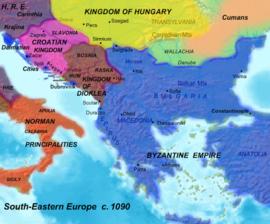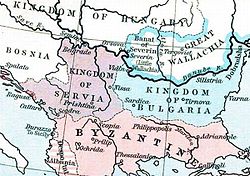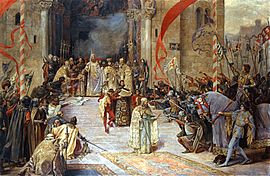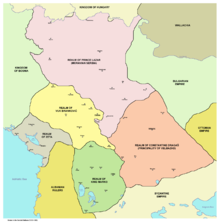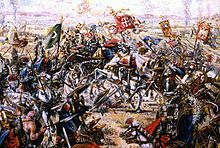- Serbia in the Middle Ages
-
Тhe medieval history of Serbia begins in the 5th century AD with the Slavic invasion of the Balkans, and lasts until the Ottoman occupation of 1540.
Contents
Early Middle Ages
Slavic invasion
History of Serbia 
This article is part of a seriesBy century 9th · 10th Prehistory Starčevo · Vinča · Scordisci · Triballi Roman (Illyria; Moesia · Pannonia · Dacia) Middle Ages Principality (768-969) (Rascia · Doclea · Zachlumia · Travunia · Pagania) Catepanate · Theme (969–1043) Vojislavljević Doclea (998–1101) Grand Principality (1101–1217) Kingdom (1217–1346) Empire (1346–1371) Fall · Lazar's Serbia (1371–1402) Despotate (1402–1459) Early modern Ottoman (1402–1912) Habsburg Kingdom of Serbia (1718–1739) Great Serb Migrations Modern Serbia Revolution (1804–1815) Principality of Serbia (1817–1882) Kingdom of Serbia (1882–1918) Yugoslavia (1918–1990/2006) German Occupation (1941–1944) Socialist Republic (1944–1990) Federal Republic, then State Union (1990–2006) Republic of Serbia (since 2006) Timeline
Serbia Portal
Main article: Slavic invasion of the BalkansFurther information: Early SlavsThe Slavs invaded Balkans during Justinian I rule (527–565), when eventually up to 100,000 Slavs raided Thessalonica. The Western Balkans was settled with Sclaveni (Sklavenoi), the east with Antes.[1]
The Sklavenoi plunder Thrace in 545.[2] In 551, the Slavs crossed Niš initially headed for Thessalonica, but ended up in Dalmatia. During the 6th and 7th century CE, Slavic tribes made eight attempts to take Niš and in the final attack in 615 the Slavs took the city.[2][3]
Menander Protector mentions a King of the Sklavenoi, Daurentius (577-579) that slayed an Avar envoy of Khagan Bayan I. The Avars asked the Slavs to accept the suzerainty of the Avars, he however declined and is reported as saying: "Others do not conquer our land, we conquer theirs [...] so it shall always be for us".[4]
In 577 some 100,000 Slavs poured into Thrace and Illyricum, pillaging cities and settling down.[5] By the 580s, as the Slav communities on the Danube became larger and more organised, and as the Avars exerted their influence, raids became larger and resulted in permanent settlement. In 586 AD, as many as 100,000 Slav warriors raided Thessaloniki. By 581, many Slavic tribes had settled the land around Thessaloniki, though never taking the city itself, creating a Macedonian Sclavinia.[6] As John of Ephesus tells us in 581: "the accursed people of the Slavs set out and plundered all of Greece, the regions surrounding Thessalonica, and Thrace, taking many towns and castles, laying waste, burning, pillaging, and seizing the whole country."
Archaeological evidence in Serbia and Macedonia conclude that the White Serbs may have reached the Balkans earlier than thought, between 550-600, as much findings; fibulae and pottery found at Roman forts point at Serb characteristics and thus could have been either part of the Byzantine foedorati or a fraction of the early invading Slavs who upon organizing in their refuge of the Dinarides, formed the ethnogenesis of Serbs and were pardoned by the Byzantine Empire after acknowledging their suzerainty.[2]
According to Constantine Porphyrogenitus, a Byzantine Emperor who ruled during the 10th century, the Serbs migrated from White Serbia and initially settled around the region of Thessaloniki. Not to their liking, they instead settled a region farther south[7]- a large proportion of what had been the Roman province of Illyricum. On the Adriatic coast, these Serbs formed four coastal principalities known as Neretva, Zahumlje, Konavli and Trebinje and Duklja. Inland (to the east of the Dinaric Alps) lay a large territory stretching north as far as the Sava River, and included the region of Bosnia. It retained the old name of Serbia, often called Baptised Serbia by the Byzantines, because it was Christianized (unlike the still pagan White Serbs in northern Europe).[8]
Constantine's work, De Administrando Imperio, has attracted intense academic debate. On the one hand, some scholars hold it to be a true account of the situation, thus concluding that Neretvians, Zachlumians, Dukljians, Travunians and southeastern Bosnians are descendants of Serbs that took on new tribal names, and due to geographical and political factors developed an often independent history from Raska, the region of Serbia proper that became synonymous with the name Serbia from the 12th century onwards.[9] Others argue that Constantine's account may have merely been a reflection of the political situation during his time (i.e. the 10th century[10]) - whereby his liege Časlav Klonimirović wielded command over the various Slavic lands south of the Cetina and Vrbas rivers. Moreover, although possible, there is little archaeological evidence supporting a long-distance Serb migration from White Serbia,[11] and indeed little evidence that a political entity known as White Serbia actually existed.[12] There were a few South Slavic tribes in the Middle Ages that had contemporary name-sakes amongst Western and Eastern Slavic tribes, such as the Croats, Severians and Abodrites. We do not know whether it actually represented a shared identity.[13] Florin Curta suggests that the Serbs might have been a clan of Slavic-speaking warriors, who formed within the Balkans, and slowly extended their power, and hence their name, over a greater territory.[14]
The early history of Serbia is characterised by one of fluctuating borders and shifting centres of rule. For much of this period, there were several Serb states existing at any one time. Daniele Farlati used the term Serbia Primorje (Serbia by the sea) when referring to the coastal provinces, whilst he called the interior part Serbia Zagorje.[15] The two most prominent Serb states were Duklja (or Zeta) and Raška; they provided the territorial nucleus for a succession of Serb kingdoms that in the 13th century were consolidated under the Nemanjić dynasty.[16] Centred in Raška, the Nemanjićs ushered a golden period in Serbian history, whereby it became a dominant Balkan power.[17] Henceforth the name Serbia became synonymous with the state of Raška.
Medieval Greek and Latin historiographers call the Serbians "Triballi". This does not necessarily indicate a relation of Serbians with the ancient tribe with the same name. Laonikos Chalkokondyles (1430–1490) says that at his time the Triballian land is around the area where river Morava meets Istrus (Danube) river ("... per regionem Triballorum. Ea autem region est, quam alluit Morabas fluvius, et in Istrum effunditur.").[18]First Serbian Principality
See also: 9th century in Serbia and 10th century in SerbiaUpon their initial arrival, the Slavs formed no uniform political organization, but rather remained divided into many tribes of various sizes, referred to as Sklaviniai by the Byzantines.[7] These groups were led by native chiefs.[19] Perhaps the tribes were organized into župa, a form of territorial organization learned from the native Illyrians, being roughly equivalent to a county.[20] Each župa consisted of several villages, linked by clan (i.e. extended family) relationships.[21]
An embryonic Serbian state formed in the 9th century. At this time, the Bulgarian Khanate was expanding westward, and had already installed Bulgar despots over the Slavic tribes which inhabited what is present-day northern Serbia - the Srem region and eastern Slavonia.[22] At the same time, it pushed into Macedonia from the south, effectively encircling the Serbs. As a response to this, with Byzantine support, a few Serbian zhupa united defensively under the lead of Knez (‘Prince’) Vlastimir- the founder of the Vlastimirovic dynasty.[23] The extent and location of this early Serb principality is not known with certainty, but it probably lay in present day southern Serbia and southeastern Bosnia "in the difficult country between the Rivers Drina and Ibar".[24][25][26][27] In between the Serb principality and the Adriatic coastline existed three minor 'principalities', Travunia, Zachlumia and Pagania. At this time Duklja did not exist as a political entity, as its eastern parts were part of Vlastimir's realm whilst the coastal cities were ruled by Byzantine governors.[28] To the north, the Croats were beginning to consolidate into a Principality, whilst to the east loomed the Bulgarian Empire. Archaeological evidence shows that the fort of Ras, marked the early Serb-Bulgarian border.[29][30]
The Bulgarian invasion came sometime in the 840s, but was repelled by Knez Vlastimir. Vlastimir gave his daughter's hand to the son of the Zhupan of Travunia, Balaes. This established a long-lasting allegiance. Travunia henceforth acknowledged Serbia's authority, and was incorporated in Serbia as a semi-independent principality. Vlastimir's sons- Mutimir, Gojnik and Stojmir- defeated another Bulgarian attack c.853, capturing Khan Boris’ son, Vladimir, and twelve leading boljars. They escorted Vladimir to Ras, at the Serb-Bulgarian border, exchanged gifts and concluded a peace treaty. However, this early princedom was far from a consolidated, centralized state, and the various zhupans retained considerable independence.[31] Rather than practising primogeniture, Slavic rulers practiced staresina,[32] where rule fell upon the eldest person in the extended family (rather than the son of the King). The realm would then be split between the surviving brothers, sons, nephews and cousins. Such tradition repeatedly caused succession strife.
Sometime after defeating the Bulgarians, Mutimir ousted his brothers (who fled to Bulgaria). He kept Gojnik's son Peter in his court, but he managed to escape to Croatia. Mutimir ruled until 890, being succeeded by his son Prvoslav. However, Prvoslav was overthrown by Petar Gojnikovic, who had returned from his exile in Croatia c. 892. The name Peter is Christian; suggesting that Christianity had started to permeate into Serbia, undoubtedly through Serbia's contacts with the Bulgarians and Byzantines. Peter secured himself on the throne (after fending off a challenge from Klonimir, son of Stojmir) and was recognised by Tsar Symeon of Bulgaria. An alliance was signed between the two states. Already having Travunia's loyalty, Peter began to expand his state north and west. He annexed the Bosna River valley,[10] and then moved west securing allegiance from the Pagans - who were fiercely independent, pirateering Slavs. However, Peter's expansion into Dalmatia brought him into conflict with Prince Michael of Zahumlje. Michael had also grown powerful, ruling not only Zachlumia, but exerting his influence over Travunia and Dioklea. Porphyrogenitus explains that Michael's roots were different from Vlastimirovici, and was unwilling to yield authority to Peter.
Although allied to Symeon, Peter became increasingly disgruntled by the fact that he was essentially subordinate to him. Peter's expansion toward the coast facilitated contacts with the Byzantines, by way of the strategos of Dyrrachium. Searching for allies against Bulgaria, the Byzantines showered Peter with gold and promises of greater independence if he would join their alliance- a convincing strategy. Peter might have been planning an attack on Bulgaria with the Magyars, showing that his realm had stretched north to the Sava river.[10] However, Michael of Zahumlje fore-warned Symeon of this plan, since Michael was an enemy of Peter, and a loyal vassal of Symeon. What followed was multiple Bulgarian interventions and a succession of Serb rulers. Symeon attacked Serbia (in 917) and deposed Peter, placing Pavel Branovic (a grandson of Mutimir) as Prince of Serbia, subordinate to Symeon (although some scholars suggest that Symeon took control over Serbi directly at this time).[33] Unhappy with this, the Byzantines then sent Zaharije Prvoslaviljevic in 920 to oust Pavel, but he failed and was sent to Bulgaria as prisoner. The Byzantines then succeeded in turning Prince Pavel to their side. In turn, the Bulgarians started indoctrinating Zaharije. Zaharije invaded Serbia with a Bulgarian force, and ousted his cousin Pavel in 922. However, he too turned to Byzantium. A punitive force sent by the Bulgarians was defeated. Zaharije sent the heads of the Bulgarian generals to Emperor Romanus as a sign of his loyalty to the Byzantines. Thus we see a continuous cycle of dynastic strife amongst Vlastimir's successors, stirred on by the Byzantine and Bulgarians, who were effectively using the Serbs as pawns. Whilst Bulgarian help was more effective, Byzantine help seemed preferable.[10]
Simeon made peace with the Byzantines to settle affairs with Serbia once and for all. Frustrated by the traitorous smaller neighbor militarily, the Bulgarians decided to finish the things once and for all. In 924, he sent a large army accompanied by Časlav, son of Klonimir. The army forced Zaharije to flee to Croatia. The Serbian zhupans were then summoned to recognize Čáslav as the new Prince. When they came, however, they were all imprisoned and taken to Bulgaria, as too was Čáslav. Much of Serbia was ravaged, and many people fled to Croatia, Bulgaria and Constantinople. Simeon made Serbia into a Bulgarian province, so that Bulgaria now bordered Croatia and Zahumlje. He then resolved to attack Croatia, because it was a Byzantine ally and had sheltered the Serbian Prince. At the battle of the Bosnian highlands, Croatia's King Tomislav defeated the Bulgarians, whilst Prince Michael of Zahumlje maintained neutrality. During the fall of central Serbia, Michael was the pre-eminent Serb prince, having been awarded the honorary title of Patriakos by the Byzantine Emperor, and may have ruled over Zachlumia, Travunia and Dioklea.
The Bulgarian subjugation of Serbia was for only three years. After Symeon died, Časlav Klonimirović (927 - c. 960s) led Serb refugees back to Serbia. He secured the allegiance of the Dalmatian duchies and expelled Bulgarian rule from central Serbia. After Tomislav's death, Croatia was in near anarchy as his sons vied for sole rule, so Čáslav was able to extend his rule north to the Vrbas river (gaining the allegiance of the chiefs of the various Bosnian zhupa).[11] During this apogee of Serbian power, Christianity and culture penetrated Serbia as the Serb prince lived in peaceful and cordial relations with the Byzantines.
However, strong as it had grown to be, Serbia's power (as other early Slavic states) was only as strong as its ruler. There was no centralized rule, but was a more a confederacy of Slavic principalities. The existence of the unified Grand Principality was dependent on the allegiance of the lesser princes to Časlav. When he died defending Bosnia against Magyar incursions (sometime between 950–960), the coalition disintegrated. The various zhupans and princes previously loyal to Časlav undoubtedly tried to carve out their own realms, falling into conflict with each other.[10] We do not know the details, and we do not know the names of any rulers- perhaps because no one was prominent enough to be noted. We do know that in the 990s, Jovan Vladimir rose as the most powerful Serbian noble, carving out a principality centered on the coast of modern Montenegro. This state became known as Duklja, after the ancient Roman town of Doclea. However, by 997, it had been conquered and made subject to Bulgaria again by tsar Samuel. When the Byzantines finally defeated the Bulgarians, they regained control over most of the Balkans for the first time in four centuries. Serbian lands were governed by a strategos presiding over the Theme of Sirmium. However, local Serbian princes continued to reign as suzerains to the Byzantines, maintaining total autonomy over their lands, such as the zhupanate of Rascia while only nominally being Byzantine vassals.[citation needed] Forts were maintained in Belgrade, Sirmium, Nis and Branicevo. These were, for the most part, in the hands of local nobility, which often revolted against Byzantine rule.
High Middle Ages
Emergance and fall of Duklja under the Vojislavljević
Main article: DukljaFor the next 150 years, the mantle of leadership of the Serbs passed to the coastal areas, where the principality of Duklja had arisen. The dynasty began by prince Stefan Vojislav created a powerful and influential state that took all Serbian lands from under the Byzantine rule. During this time, we know very little about the events in Serbia Zagorje (inland), because Byzantine attention was focused primarily on the coastal Serbs.[34] Duklja was also the first Serbian kingdom, which gained international recognition. Prince Mihajlo received the king's crown from the Pope in 1077. His successor king Bodin enlarged the domain, but the Kingdom of Duklja didn't last for a long time. Byzantine Empire conquers Duklja in 1101.
Vukanović dynasty of Rascia
The Serbian Grand Principality, also known as Rascia, was founded in 1090, and ended with the elevation to Kingdom in 1217. During the reign of Constantine Bodin, the King of Duklja, Vukan was appointed to rule Rascia as a vassal, and when Bodin was captured by the Byzantines, Vukan became independent and took the title of Grand Prince. When Bodin had died, Rascia became the strongest entity, in which the Serbian realm would be seated, in hands of the Vukanović dynasty. Uroš I, the son of Vukan, ruled Serbia when the Byzantines invaded Duklja, and Rascia would be next in line, but with diplomatic ties with the Kingdom of Hungary, Serbia retained its indepence. Uroš II initially fought the Byzantines, but after a defeat soon gives oaths of servitude to the Emperor. Desa, the brother of Uroš II and an initial Byzantine ally, turned to Hungarian support, but was deposed in 1163, when Stefan Tihomir of a cadet line (which would become Nemanjić dynasty), was put on the throne by the Emperor.
Nemanjić dynasty
Main articles: Kingdom of Serbia (medieval) and Serbian Empire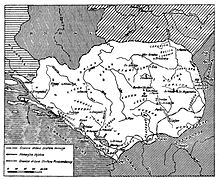 Nemanjić's Serbia, 1150–1220, during the reigns of Stefan Nemanja and Stefan Prvovenčani
Nemanjić's Serbia, 1150–1220, during the reigns of Stefan Nemanja and Stefan Prvovenčani
Stefan Nemanja was succeeded by his middle son Stefan, whilst his first-born son Vukan was given the rule of the Zeta region (present-day Montenegro). Stefan Nemanja's youngest son Rastko became a monk and took the name Sava, turning all his efforts to spread religion among his people. Since the Roman Catholic Church already had ambitions to spread its influence to the Balkans as well, Stefan used these propitious circumstances to obtain his crown from the Pope, thereby becoming the first Serbian king, in 1217. In Byzantium, his brother Sava managed to secure autocephaly (independence) for the Serbian Church and became the first Serbian archbishop in 1219. In the same year Sava published the first constitution in Serbia — St. Sava's Nomocanon (Serbian: Zakonopravilo).[35][36][37] This legal act was well developed. St. Sava's Nomocanon was the compilation of Civil law, based on Roman Law[38][39] and Canon law, based on Ecumenical Councils and its basic purpose was to organize functioning of the young Serbian kingdom and the Serbian church. Thus the Serbs acquired both forms of independence: political and religious.
The next generation of Serbian rulers — the sons of Stefan Prvovenčani — Radoslav, Vladislav and Uroš I, marked a period of stagnation of the state structure. All three kings were more or less dependent on some of the neighbouring states — Byzantium, Bulgaria or Hungary. The ties with the Hungarians played a decisive role in the fact that Uroš I was succeeded by his son Dragutin whose wife was a Hungarian princess. Later on, when Dragutin abdicated in favor of his younger brother Milutin (in 1282), the Hungarian king Ladislaus IV gave him lands in northeastern Bosnia, the region of Mačva, and the city of Belgrade, whilst he managed to conquer and annex lands in northeastern Serbia. Thus, some of these territories became part of the Serbian state for the first time. His new state was named Kingdom of Srem. In that time the name Srem was a designation for two territories: Upper Srem (present day Srem) and Lower Srem (present day Mačva). Kingdom of Srem under the rule of Stefan Dragutin was actually Lower Srem, but some historical sources mention that Stefan Dragutin also ruled over Upper Srem and Slavonia. After Dragutin died (in 1316), the new ruler of the Kingdom of Srem became his son, king Vladislav II, who ruled this state until 1325.
Under the rule of Dragutin's younger brother — King Milutin, Serbia grew stronger despite having to occasionally fight wars on three different fronts. King Milutin was an apt diplomat much inclined to the use of a customary medieval diplomatic and dynastic marriages. He was married five times, with Hungarian, Bulgarian and Byzantine princesses. He is also famous for building churches, some of which are the finest examples of Medieval Serbian architecture: the Gračanica monastery in Kosovo, the Cathedral in Hilandar monastery on Mount Athos, the St. Archangel Church in Jerusalem etc. Because of his endowments, King Milutin has been proclaimed a saint, in spite of his tumultuous life.
Late Middle Ages
 Serbian Empire, 1355 A.D.
Serbian Empire, 1355 A.D.
Milutin was succeeded on the throne by his son Stefan, later dubbed Stefan Dečanski. Spreading the kingdom to the east by winning the town of Nis and the surrounding counties, and to the south by acquiring territories on Macedonia, Stefan Dečanski was worthy of his father and built the Visoki Dečani monastery in Metohija — the most monumental example of Serbian Medieval architecture — that earned him his nickname. Stefan Dečanski defeated the Bulgarians in Battle of Velbužd in 1330.
In 1333 the Republic of Dubrovnik bought the Pelješac peninsula from the Serbian king Stefan Dušan.
Medieval Serbia reached its apex in the middle of the 14th century, during the rule of Tsar Dušan. In that time Dušan's Code (Serbian: Dušanov zakonik)[40] was enacted in 1349 and added in 1354. The Code was based on Roman-Byzantine law. The legal transplanting is notable with the articles 171 and 172 of Dušan's Code, which regulated the juridical independence. They were taken from the Byzantine code Basilika (book VII, 1, 16-17). Tsar Dušan opened new trade routes and strengthened the state's economy. Serbia flourished, becoming one of the most developed countries and cultures in Europe. Medieval Serbia had a high political, economic, and cultural reputation in Europe.
Taking advantage of the Byzantine civil war of 1341–1347, Dušan doubled the size of his kingdom seizing territories to the south, southeast and east at the expense of Byzantium and conquered almost the entire territory of today's Greece, except the Peloponnese and the islands. After he conquered the city of Serres, he was crowned the Emperor of Serbs and Greeks by the first Serbian Patriarch in 1346. He was attempting to become the successor of the Byzantine Emperors. Before his sudden death, Stefan Dušan tried to organize a Crusade with the Pope against the threatening Turks. He died in December 1355 at the age 47.
Decline and Ottoman conquest
Main articles: Serbian Despotate and Moravian SerbiaTsar Stefan Dušan was succeeded by his son Uroš, called the Weak, a term that might also apply to the state of the kingdom, as it slowly slid into feudal anarchy. This is a period marked by the rise of a new threat: the Ottoman Turk sultanate, which gradually spread from Asia to Europe and conquered Byzantium first, and then the other Balkan states. Serbia was divided between the feudal lords. The most powerful was Vukašin Mrnjavčević, who was the right hand of Stefan Uroš, but he died in the Battle of Maritsa in his campaign to drive the Turks out of Europe. Tsar Uroš died several months later, and with his death, the Nemanjić dynasty was over. However, a new figure emerged - Lazar Hrebeljanović, who managed to unite most of Serbia with war and diplomacy. He could not unite all of Serbia, because some of the regional feudal lords were significantly powerful, and yet he had to fight the greater threat, the Ottoman Empire. The first raids on Lazar's territory began in 1381, but the real invasion came in 1389. Lazar gathered every soldier he could, leading Serbian army to face the Turks.
On 28 July 1389 the two armies met at Kosovo, in what became known as the Battle of Kosovo. The attack began with the Serbs penetrating the first 2 lines of the Turkish army, and completely destroyed the right flank, under the command of the sultan's son, Yakub. At one point in the battle, a Serbian knight Miloš Obilić managed to assassinate the Ottoman sultan, Murad I. His son, Bayezid I, took command of the army and managed to defeat the Serbs and to capture Prince Lazar and execute him. The losses are unknown, but it is said that the Serbian-led army fought to the last man. After the Battle of Kosovo there was no army among the Balkan states capable of halting the advancing Ottoman Empire and the first victim was the Bulgarian Tarnovo state, which fell four years later. Serbia however managed to recuperate under despot Stefan Lazarević, surviving for 70 more years, experiencing a cultural and political renaissance, but after Stefan Lazarević's death, his successors from the House of Branković did not manage to stop the Ottoman advance. Serbia finally fell under the Ottomans in 1459, and remained under their occupation until 1804, when Serbia finally managed to regain its sovereignty from the Ottomans.
See also
- Rascia
- Serbian Empire
- Serbian Despotate
References
- ^ Hupchick, Dennis P. The Balkans: From Constantinople to Communism. Palgrave Macmillan, 2004. ISBN 1-4039-6417-3[page needed]
- ^ a b c http://www.rastko.rs/arheologija/delo/13047
- ^ BG III 40
- ^ Curta (2001), pp. 91–92, 315
- ^ [1][page needed]
- ^ Cambridge Medieval Encyclopedia, Volume II.[page needed]
- ^ a b The Serbs. Sima Cirkovic. Blackwell Publishing. 2004. ISBN 0-631-20471-7[page needed]
- ^ The early Medieval Balkans. A Critical Survey from the 6th to the Late 12th Century. John V A Fine. The University of Michigan Press. 1991. ISBN 0-472-08149-7. Pg 52 Great Croatia called White was still unbaptized in his (Constantine's) day as were the Serbs who are neighbouring it
- ^ The Serbian Origin of Montenegrins
- ^ a b c d e Fine
- ^ a b Florin Curta. The Making of the Slavs
- ^ Southeastern Europe in the Middle Ages 500–1250. Florin Curta. Cambridge Medieval Textbooks
- ^ The Early Slavs. Culture and Society in Early Medieval Europe. Cornell University Press, 2001. ISBN 0-801-431-779
- ^ Southeastern Europe in the Middle Ages 500–1250. Florin Curta. Cambridge Medieval Textbooks. NB Curta applies the example primarily to the Croats, for whom the early archaeological evidence is, at present, more available. He suggests that perhaps a similar process occurred for th Serbs.
- ^ Illyria Sacrum. D Farlati. 1751
- ^ Encyclopædia Britannica Online; Montenegro
- ^ The Balkans. From Constantinople to Communism. D Hupchik
- ^ Chalcocondylus Laonicus (Chalcondyles) Historiarum de origine ac Rebus gestis Turcorum, book 7, pp. 349 (Greek text), 351 (Latin text). Available on line as pdf file.
- ^ Hupchik. Pg 35 They lived in tribal groups led by native chiefs
- ^ Fine. Pg 38 zupa organisation seems to have been heavily influenced by the earlier Illyrian territorial organization
- ^ Paul Barford. The Early Slavs. Culture and Society in Early Medieval Eastern Europe. Cornell University Press. 2001. ISBN 0-8014-3977-9. Pg 129
- ^ The early Medieval Balkans. J V A Fine. Pg 107
- ^ Hupchik. Pg 39–40: a small Serb state ruled by one Vlastimir arose in the 9th century. Bulgar westward expansion might have inspired some Serb tribes to unite defensively under Vlastimir's authority. The Byzantines sent agents and gold to encourage Serb unification
- ^ Quote from: Entry of the Slavs into Christendom: An Introduction to the Medieval History of the Slavs. A. P. Vlasto. Serbia, part 1
- ^ The Early Medieval Balkans. A Critical Survey from the 6th to the late 12th century. John Fine. Pg 53 The Serbs settled far to the south of what we now think of as the centre of Serbia
- ^ Florin Curta. Southeastern Europe in the Middle Ages, 500–1250. Cambridge Medieval Textbooks. . Pg 146. in the valleys of the upper Drin and Lim rivers (southeastern Bosnia and southwestern Serbia).....in the late 800s, the region of Ras was a frontier district of Bulgaria
- ^ The Balkans. From Constantinople to Communism. D Hupchik. Pg 39 In the mountains south of Dalmatian Croatia and west of the Morava River..
- ^ The early Medieval Balkans. J V A Fine
- ^ Southeastern Europe in the Middle Ages. Florin Curta
- ^ Cirkovic. Pg 12
- ^ Fine. Pg 57 the nobles retained great local independence
- ^ The Serbs. Sima Crikovic
- ^ Entry of the Slavs into Christendom: An Introduction to the Medieval History of the Slavs.A Vlasto
- ^ The Serbs. Sima Cirkovic
- ^ Alan Watson Foundation
- ^ "Nomocanon". Search.com Reference. http://www.search.com/reference/Nomocanon. Retrieved 2010-07-25.
- ^ John V. A. Fine (1994). The Late Medieval Balkans: A Critical Survey from the Late Twelfth Century to the Ottoman Conquest. ISBN 978-0-472-08260-5. http://books.google.com/books?id=QDFVUDmAIqIC&pg=PA118. Retrieved 2010-07-25.
- ^ S. P. Scott (1932). The Civil Law: Vol. I. Constitution.org. http://www.constitution.org/sps/sps.htm. Retrieved 2010-07-25.
- ^ Yves LASSARD, Alexandr KOPTEV. "The Roman Law Library". Web.upmf-grenoble.fr. http://web.upmf-grenoble.fr/Haiti/Cours/Ak/. Retrieved 2010-07-25.
- ^ "Serbian Culture of the 14th Century. Volume I". Dusanov Zakonik. http://www.dusanov-zakonik.com/indexe.html. Retrieved 2010-07-25.
External links
Preceded by
Roman SerbiaMedieval Serbia
476-1540 ADSucceeded by
Ottoman Serbia Serbia topics
Serbia topicsBasic topics History Prehistoric Serbia:Roman Serbia:Middle Ages:White Serbs · Serbian Sklavinia · Medieval Serbian Principality (provinces of Rascia, Bosnia, Diocleia, Travunia, Zachlumia, Pagania) · Serbian Grand Principality · Serbian Kingdom · Serbian Empire · Ottoman Serbia
Politics Constitution · President · Prime Minister · National Assembly · Political parties · Elections · Foreign relations · Government · History · Armed Forces · Air Force · Law enforcement · Nationality law · LGBT rightsGeography Administrative:Landforms:Economy Culture Architecture · Beer · Cinema (Films) · Cuisine · Literature (Medieval) · Cultural Heritage (UNESCO sites) · Media · Music · Serbian Orthodox Church · Sport · Television · Public holidays · History · Education · Human rights (LGTB rights) · Languages · Religion · Subdivisions · Districts · Crime · Serb people (List)WikiProject • Portal • Commons European Middle Ages by region Medieval histories
of current political unitsWestern and
Northern EuropeCentral, Eastern Europe
and Near EastMedieval territories Western and
Northern Europe- Frankish Empire
- Holy Roman Empire (Kingdom of Bohemia, Kingdom of Italy, Swiss Confederacy)
- Papal States
- Kingdom of Sicily
- Kingdom of Naples
- Duchy of Burgundy (Burgundian Netherlands)
- Kingdom of Aragon
- Kingdom of England
- Kingdom of Scotland
- Lordship of Ireland
- al-Andalus (Caliphate of Córdoba, Taifa, Almoravids)
- Hereditary Kingdom of Norway
Central, Eastern Europe
and Near East- Byzantine Empire
- Bulgarian Empire (First Empire, Second Empire)
- Croatia (Littoral, Pannonia, Kingdom of Croatia)
- Crusader states (Cyprus, Jerusalem)
- Kingdom of Bosnia
- Duchy of Saint Sava
- Russia (Rus' Khaganate, Kievan Rus', Ryazan, Novgorod Republic, Moscow)
- Serbia (Principality, Grand Principality, Kingdom, Empire, Lordship, Despotate)
Categories:- Medieval Serbia
- History of Serbia
Wikimedia Foundation. 2010.


